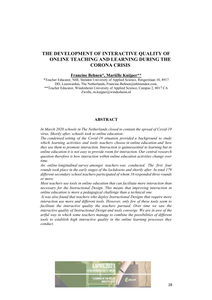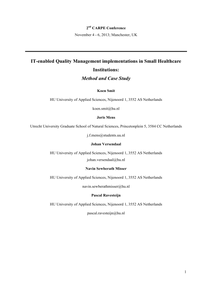Research conducted by Henk van den Hurk shows that teachers’ knowledge of effective instructional behaviour is of limited influence on their actual performance in daily teaching. Observing teachers within their own educational practice and the subsequent feedback in teacher training college, however, has shown to be effective in improving teacher instructional practice. Van den Hurk studied the effects of the application of a cyclic model for data-feedback in initial teacher training as well as in a master course for teachers. In the applied model, teachers are observed with standardised observational instruments, while teaching their own classes. Back in teacher training college they are supported in formulating specific points of improvement for their own instructional behaviour. Subsequently, in their own classroom, the students practice the skills they further have to develop. After a short while another classroom observation is scheduled. The use of this model has proven to lead to a substantial improvement of teacher instructional behaviour. It is remarkable that advances in the quality of teacher instructional behaviour are reached in a limited time-span of only several weeks.
LINK
In March 2020 schools in The Netherlands closed to contain the spread of Covid-19 virus. Shortly after, schools took to online education. The condensed setting of the Covid-19 situation provided a background to study which learning activities and tools teachers choose in online education and how they use them to promote interaction. Interaction is quintessential to learning but in online education it is not easy to provide room for interaction. Our central research question therefore is how interaction within online education activities change over time. An online longitudinal survey amongst teachers was conducted. The first four rounds took place in the early stages of the lockdowns and shortly after. In total 179 different secondary school teachers participated of whom 16 responded three rounds or more. Most teachers use tools in online education that can facilitate more interaction than necessary for the Instructional Design. This means that improving interaction in online education is more a pedagogical challenge than a technical one. It was also found that teachers who deploy Instructional Designs that require more interaction use more and different tools. However, only few of these tools seem to facilitate the interactive quality the teachers pursued. Over time we saw the interactive quality of Instructional Design and tools converge. We are in awe of the artful way in which some teachers manage to combine the possibilities of different tools to establish high interactive quality in the online learning processes they conduct.
DOCUMENT

This article focuses on improving the instructional quality of student teachers in elementary education. We developed a coaching approach involving classroom observation and appropriate lesson preparation and feedback templates. Using an untreated control group design with pre-test and posttest (n = 198), we answered the question ‘whether student teachers who learned to teach with the new coaching approach achieved a higher level of pedagogical and didactical teaching skills compared to student teachers who did not receive this approach’. The effect variable used was the observation instrument ICALT. We compared the average scores of the control group and the experimental group on the posttest (ANCOVA). The differences found on the posttest, after controlling for the confounding variables, were significant on all ICALT scales. These effect sizes are medium on the scales; ‘Safe climate’ and ‘Clear instruction’ and large on the scales; ‘Classroom management’ ‘Activating pupils’ ‘Adaptive teaching’ and ‘Teaching learning strategies’.
DOCUMENT
High-quality interactions between young children and teachers in early childhood education and care (ECEC) are the cornerstone of educational quality. International findings suggest that the quality of interactions that support emotions and classroom organization is at a medium to high level, but the quality of instructional support is at a lower level. Within the “Teaching Through Interactions” framework developed by Hamre and colleagues (2013), several efforts were made to evaluate and improve key teacher-child interactions through in-service training. Our review includes experimental studies that evaluate professional development using the Classroom Assessment Scoring System measures. The systematic literature search and coding of studies was carried out by two independent reviewers. Our review includes 15 recent studies with 18 treatments. The meta-analysis (random effect model) showed an overall statistically significant professional development effect of g = 0.39 (SE = .08), i.e. close to a medium-size effect. In addition, effect sizes were almost equal for interactions related to emotional support, classroom organization, and instructional support (g= 0.35, 0.30, and 0.43, respectively). The quality of experimental studies and professional development was at a high level (e.g., individual component, feedback, or modeling) and experimental findings were generally positive. Our meta-analysis indicates that high-quality in-service programs have the strength to improve teacher-child interactions and pedagogical quality across all three domains.
DOCUMENT
There are lots of definitions of quality, and also of quality in education. Garvin (1984)discerns five approaches: the transcendental approach, the product-oriented approach, the customeroriented approach, the manufacturing-oriented approach and the value-for-money approach. Harvey and Green (1993) give five interrelated concepts of quality as: exceptional, perfection (or consistency), fitness for purpose, value for money and transformative. A new definition of quality is needed to explain recent quality issues in higher education. This article describes a quality concept with four constituents: object, standard, subject and values. The article elaborates on the values. Four value systems derived from Beck and Cowan (1996) are transformed into four value systems on quality and quality management: control, continuous improvement, commitment and breakthrough. These value systems make it possible to explain some recent developments in quality management in higher education.
DOCUMENT

This paper discusses two studies - the one in a business context, the other in a university context - carried out with expert educational designers. The studies aimed to determine the priorities experts claim to employ when designing competence-based learning environments. Designers in both contexts agree almost completely on principles they feel are important. Both groups emphasized that one should start a design enterprise from the needs of the learners, instead of the content structure of the learning domain. However, unlike business designers, university designers find it extremely important to consider alternative solutions during the whole design process. University designers also say that they focus more on project plan and desired characteristics of the instructional blueprint whereas business designers report being more client-oriented, stressing the importance of "buying in" the client early in the process.
DOCUMENT

Assistive technology supports maintenance or improvement of an individual’s functioning and independence, though for people in need the access to assistive products is not always guaranteed. This paper presents a generic quality framework for assistive technology service delivery that can be used independent of the setting, context, legislative framework, or type of technology. Based on available literature and a series of discussions among the authors, a framework was developed. It consists of 7 general quality criteria and four indicators for each of these criteria. The criteria are: accessibility; competence; coordination; efficiency; flexibility; user centeredness, and infrastructure. This framework can be used at a micro level (processes around individual users), meso level (the service delivery scheme or programme) or at a macro level (the whole country). It aims to help identify in an easy way the main strengths and weaknesses of a system or process, and thus guide possible improvements. As a next step in the development of this quality framework the authors propose to organise a global consultancy process to obtain responses from stakeholders across the world and to plan a number of case studies in which the framework is applied to different service delivery systems and processes in different countries.
DOCUMENT

Among other things, learning to write entails learning how to use complex sentences effectively in discourse. Some research has therefore focused on relating measures of syntactic complexity to text quality. Apart from the fact that the existing research on this topic appears inconclusive, most of it has been conducted in English L1 contexts. This is potentially problematic, since relevant syntactic indices may not be the same across languages. The current study is the first to explore which syntactic features predict text quality in Dutch secondary school students’ argumentative writing. In order to do so, the quality of 125 argumentative essays written by students was rated and the syntactic features of the texts were analyzed. A multilevel regression analysis was then used to investigate which features contribute to text quality. The resulting model (explaining 14.5% of the variance in text quality) shows that the relative number of finite clauses and the ratio between the number of relative clauses and the number of finite clauses positively predict text quality. Discrepancies between our findings and those of previous studies indicate that the relations between syntactic features and text quality may vary based on factors such as language and genre. Additional (cross-linguistic) research is needed to gain a more complete understanding of the relationships between syntactic constructions and text quality and the potential moderating role of language and genre.
DOCUMENT

In the dynamic environment of increasing regulations, increasing patient demand, decentralization of budgets and enforcement of efficiency, small sized healthcare institutions in the Netherlands are having a difficult time. Although these service providers are usually capable of flexibly delivering healthcare, the investment and overhead for implementing and executing on required quality management standards like ISO 9001 is difficult. In this paper we construct a method for the implementation of an IT-enabled quality management system for small sized healthcare institutions, which is applied through case study. The case organisation provides intra- and extramural care for mentally handicapped persons and young adults with a psychiatric disorder. The quality management system implementation is based on 1) a lightweight IT infrastructure (based at a secure data centre and accessible through remote login) implying secure storage of patients' medical and personal information. Furthermore, the Deming (Deming, 1982) cycle enabled processes and protocols are 2) described in an e-handbook and prototyped via an open source process management system which supports the quality regulation demanded for providing care to patients. The case study supports the validity of our method and the fact that small sized healthcare institutions are able to execute their care while adhering to ISO 9001-like standards, with limited initial costs and relatively low cost of ownership
DOCUMENT

The quality of teaching has a clear impact on student success, but how can good teaching be defined? The European QualiTePE research project, funded by the Erasmus+ programme and involving ten European countries, seeks to adress this question specifically for Physical Education (PE). The QualiTePE instrument was designed for use in teacher training and further training to enable criteria-based observation and assessment of the quality of Physical Education lessons. The instrument is designed for diverse PE teaching and learning scenarios, alongside teacher resources, facilitating the practical assessment of teaching quality in PE. The QualiTePE instrument quantifies teaching quality by assessing specific, observable teaching characteristics via questionnaire items. Each assessment is conducted by three different population groups: 1) the students 2) the PE teacher 3) an observer. The comparative analysis of the data collected from these three perspectives enables systematic and criteria‐based feedback for (prospective) teachers, identifies areas of improvement, and informs content development for PE across Europe. The QualiTePE digital web-based evaluation tool for assessing the “Quality of Teaching in Physical Education” is now available in English, German, French, Italian, Spanish, Dutch, Swedish, Slovenian, Czech and Greek.
DOCUMENT
